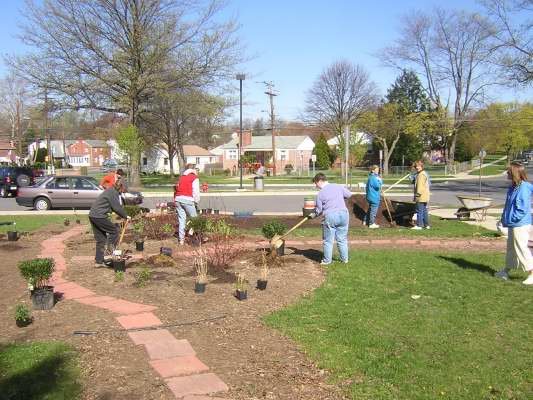


|

|
Implementing LID practices at Eastern Middle School |
|
Ed Murtagh April 18, 2005 |
Update November 2006 |
Update December 2009 |
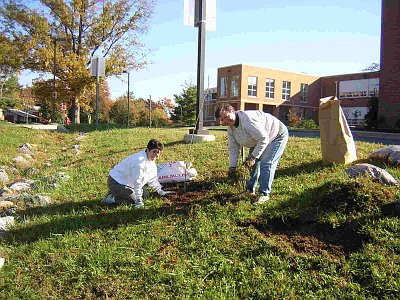 Friends of Sligo Creek members can help the creek by implementing Environmentally Beneficial Landscaping on their property, schoolyards, church grounds, etc. Environmentally Beneficial Landscaping is a form of Low Impact Development (LID). LID uses a wide array of innovative methods to retain, detain, filter, and recharge near the stormwater source. Instead of a large expensive centralized system, stormwater passes through numerous small-scale decentralized controls. The goal of LID is to restore important ecological functions in a watershed, such as hydrologic regime, while reducing stormwater runoff.
Friends of Sligo Creek members can help the creek by implementing Environmentally Beneficial Landscaping on their property, schoolyards, church grounds, etc. Environmentally Beneficial Landscaping is a form of Low Impact Development (LID). LID uses a wide array of innovative methods to retain, detain, filter, and recharge near the stormwater source. Instead of a large expensive centralized system, stormwater passes through numerous small-scale decentralized controls. The goal of LID is to restore important ecological functions in a watershed, such as hydrologic regime, while reducing stormwater runoff.
To obtain support for beneficial landscaping from a public institution in our watershed, Friends of Sligo Creek is piloting a Green Landscaping Partnership between the local watershed groups, the Eastern Middle School PTSA, and the Montgomery County Public School's Green Schools Program. Click here for a copy of the Letter of Intent for the Partnership.
The Goals of the Partnership include:
By partnering with the Eastern Middle School's PTSA, we hope to recruit volunteers who would not normally be involved with LID projects. We hope to educate them and instill a sense of participation in the restoration of the local streams and the Chesapeake Bay. One of the goals is that the workday participants and the parents of students will learn what they can do in their own yards to help improve water quality. One of the stated goals is that this project will be a model for others in the area. Using the lessons learned from this project, we intend to expand the effort by establishing other Partnerships with other public entities.
In summary there are many benefits to implementing Environmentally Beneficial Landscaping at Eastern Middle School, including:
|
Proposed Raingarden Site at Eastern
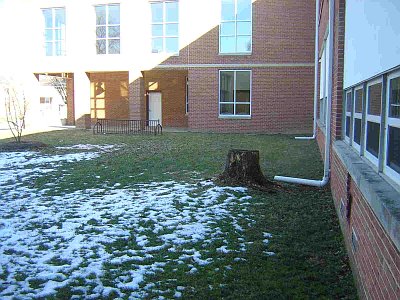
|
The existing conditions: Two rainleaders discharged runoff from the roof directly on to the schoolyard lawn. Runoff from the lawn washed mulch from nearby landscaping into the street; during the winter the runoff would freeze, creating a safety hazard. The lawn consisted of compacted soil with a sterile appearance. |
Installing a raingarden by the main entrance would not only provide a visible and high profile location, but also address the stormwater runoff problem mentioned above. Too often, property owners treat stormwater as a problem to be addressed by moving it off their property as quickly as possible, causing environmental damage to the nearby steams. Instead of treating rainwater as a problem to be removed, it will be used as a resource to enhance the schoolyard. It will be used to create colorful and interesting landscaping, while also creating a wildlife habitat and greatly increasing groundwater recharge. To fund the raingarden project, a mini-grant was obtained from the Chesapeake Bay Trust (CBT). In addition to the CBT grant, the Montgomery County Department of Environmental Protection (DEP) agreed to provide educational signage for the raingarden, and a local landscape designer donated some of her time to the project. Volunteers provided the labor.

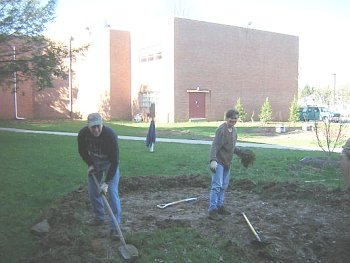
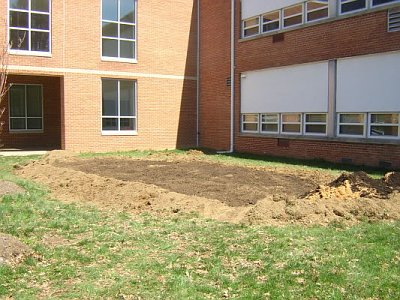
On April 16, 2005, the Partnership had their follow-up Workday. A notice about this event was included in the Eastern Middle School PTSDA newsletter. The weather was perfect and there was a good volunteer turnout. The focus on this workday was on planting. After the new plants were in place, the garden was well watered and covered over with a thin layer of mulch. Educational signage will be added later. Click here for list of plants used in the rain garden.
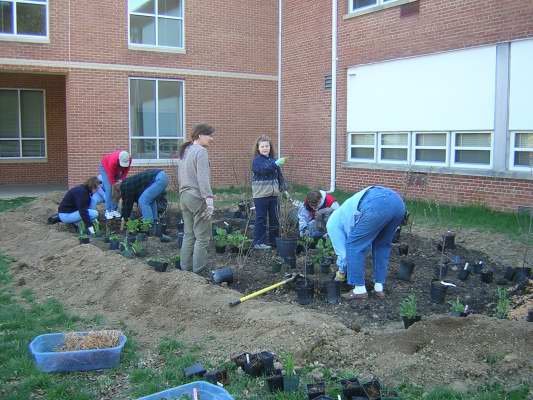
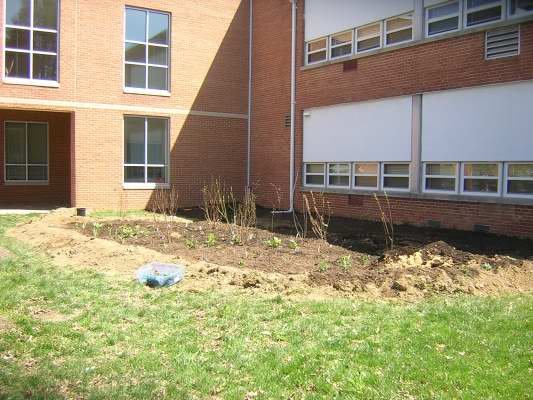
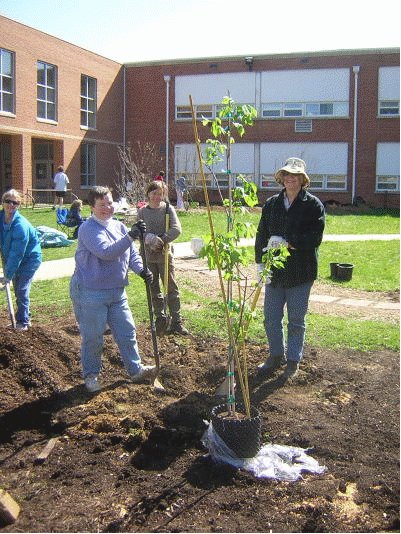 The stormwater runoff from the lawn at Eastern Middle School is one of the contributors to the degradation of the local streams and the Chesapeake Bay. One effective way to reduce stormwater runoff from the schoolyard is to replace lawn with natural landscapes. According to the Maryland Department of Environment website, beneficial landscaping - native trees, shrubs, and groundcover - will absorb fourteen times more rainwater than a grass lawn will. During our April 2005 workdays, lawn was removed and replaced with beds of native flowers and shrubs. Trees were also planted.
The stormwater runoff from the lawn at Eastern Middle School is one of the contributors to the degradation of the local streams and the Chesapeake Bay. One effective way to reduce stormwater runoff from the schoolyard is to replace lawn with natural landscapes. According to the Maryland Department of Environment website, beneficial landscaping - native trees, shrubs, and groundcover - will absorb fourteen times more rainwater than a grass lawn will. During our April 2005 workdays, lawn was removed and replaced with beds of native flowers and shrubs. Trees were also planted.
Volunteers planting a disease resistant American elm tree. According to the American Forest organization, a healthy tree will significantly reduce stormwater runoff. A healthy tree will absorb 5 gallons plus 5 gallons per caliper inch weekly. In addition to reducing runoff, trees will help cool the school building and schoolyard, improve air quality, and provide wildlife habitat.
